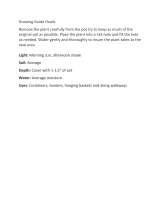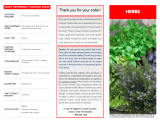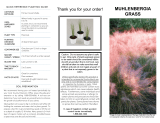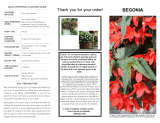
PLANTING INSTRUCTIONS
FEEDING
Feed your plants once every 2-3 weeks during the
growing season with a water soluble fertilizer for
fruits and vegetables. Discontinue feeding after
September 1st so your plants can harden off for
winter dormancy. Resume fertilizing when new
growth appears in the spring.
PRUNINGHARVESTINGWINTERIZING
Watering thoroughly in late fall will greatly enhance
your plant's cold tolerance once the ground has
frozen.
Raspberries should be winterized in late fall. In
extremely cold areas, the canes of each plant may
be tied together and wrapped in burlap. Keep in
mind that the root system is the most vulnerable to
cold damage. Mulch heavily by mounding a 6-8 inch
layer of loose soil, shredded bark, compost, leaves,
straw or other organic material around the base of
each plant.
In very cold areas, containerized plants can be
brought into an unheated, protected area such as a
garage or cellar before temperatures drop below
freezing. Check soil moisture every 2-3 weeks and
water as needed during winter.
In spring, remove mounded soil or mulch from
in-ground plantings. Containerized plants should be
moved back out into the garden sunlight where they
will begin to repeat their yearly garden perfor-
mance.
CONTINUING CARE (Continued)
Important: Thoroughly hydrate the plant by submersing
the root zone in a container of water for 10 minutes while
you prepare for planting.
1. Remove and discard the clear plastic bag from around
the pot.
2. After watering, remove the pot by holding the plant
upside down in one hand and squeezing the sides of the
pot with the other.
3. Prepare the root ball for planting by gently disturbing
the surface roots with your fingers, fork, or gardening tool
and pruning any damaged roots. This will encourage the
roots to begin growing outward into the new soil.
4. Dig a hole twice as deep and twice as wide as the plant's
root ball. Partially backfill the hole with soil and place the
plant into the hole. The top of the root ball should be level
with the ground surrounding the hole. Refill the hole with
soil, firming the soil around the plant with your fingers.
Check to be sure the plant is not planted too deeply. If it
is, raise the plant carefully and re-firm the soil.
5. Water thoroughly.
PLANTING INSTRUCTIONS (Continued)
CONTINUING CARE
Raspberries produce fruit on canes that are one year
old. These canes will die after fruiting, then new
canes will emerge in spring to replace them. In early
spring, prune off any dead canes to allow new
growth to flourish, cutting them off at the base of the
plant. Trim any dead, damaged, or unsightly growth
as needed throughout the season to maintain an
attractive appearance and a healthy plant.
Adequate and consistent watering is essential during
your plant's first year in the garden. Infrequent, long
soakings of water that thoroughly saturate the soil
are more effective than frequent, light applications of
water.
Due to variable geographical and environmental
conditions, a specific watering schedule is difficult to
define. However, as a rule of thumb, you should not
allow the soil or the original root ball to completely
dry out. During the first summer, you may need to
water as often as every few days in periods of
drought and extreme summer heat. To determine if
your plant needs water, dig a few inches into the soil
next to the plant. If the soil is dry 2-3 inches below the
surface, it is time to water.
Overwatering can be as damaging as under watering.
Be sure that the area surrounding your plant has
adequate drainage to move water away from the
plant. If you choose to plant in a container, always
select one with drainage holes to prevent your
plant's roots from sitting in water.
WATERING
Apply a 2-4 inch layer of shredded bark, compost,
leaves, straw or other organic matter around your
plants to promote moisture retention, maintain even
soil temperatures and discourage weed growth.
Replenish the mulch as needed.
MULCHING
Keep the area around your plants free of weeds.
Weeds compete with surrounding plants for food,
water and light. Walk around the garden periodically
and pull weeds, including the roots, as soon as you
see them.
Pick raspberries when the fruits have changed from
green to red but still feel firm. When ripe, the berries
should easily detach from the plant. Harvesting early
in the morning while the weather is cool prolongs the
shelf life of the berries. After picking, store the ber-
ries in a refrigerator and do not wash them until you
are ready to use them. The sweet, nutritious berries
can be eaten fresh, preserved or used for cooking.
Do not consume any other part of the plant.
WEEDING
OUT OF THE BOX
Your plants have been shipped to you in pots. We urge
you to remove them from the shipping box and plant
them as soon as possible. Should planting be delayed due
to weather or other unforeseen circumstances, roll the
plastic bag down around each plant and place them near
a bright window or other sunny location. Keep them
well-watered in their pots until permanently planted.
Once planted, they begin setting roots and, as the weath-
er warms, begin showing new growth. Please plant as
soon as possible, provide reasonable care and be patient.
The foliage on potted plants may appear slightly wilted or
yellow upon arrival. This is due to the stress of shipping
and is usually nothing to worry about. Water the plant
thoroughly, place it in a shady location and remove any
foliage that does not recover.
RASPBERRIES
SHIPPED AS SHOWN









